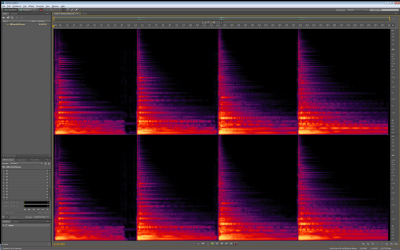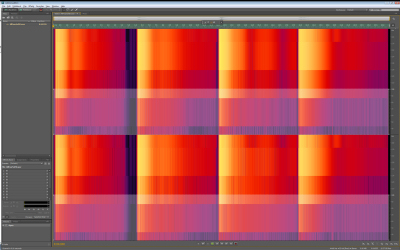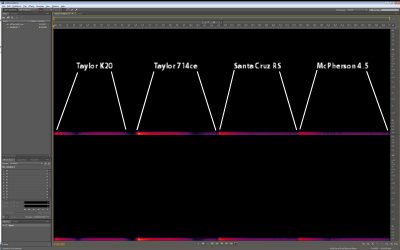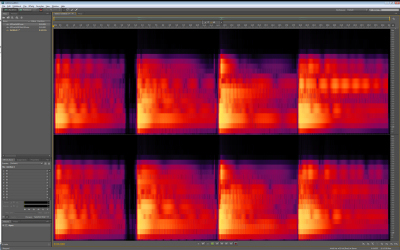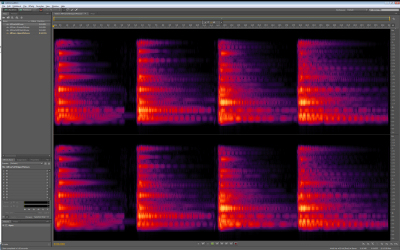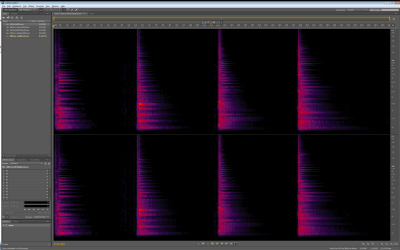Now that we've ah ... got your attention with the very well-received Acoustic Addicts pilot episode, we'd like to dig a little deeper into spectral analysis, in higher resulotion than we could provide in the video.
We're going to compare the four guitars featured in the video. I recorded a softly-played drop D chord (the low E string tuned down to a D) on each guitar, and assembled the recordings into a single WAV file, much like we did in the video with recordings of a softly-played E chord.
Again, we're using Adobe Audition CS5.5 in Spectral View to do the analysis. Take a look:
(click to enlarge)
We're looking at a stereo recording with the left channel on top of the right channel. The guitars go in the order that we presented them:
- Taylor K-20 (all koa)
- Taylor 714ce (rosewood back and sides, engelmann spruce top)
- Santa Cruz Roy Southerner (mahogany back and sides, sitka spruce top)
- McPherson 4.5 (beeswing mahogany back and sides, adirondack spruce top)
If you recall from the video, the frequency spectrum goes from very low at the bottom of the y axis to very high at the top of the y axis. The brighter the color (closest to white) the louder that range of frequencies is.
Audition's spectral view has a great feature in which you can select an area across time and frequencies, listen to just that frequency range by pressing the spacebar when a range is selected, and you can copy that range to a new file.
This is what it looks like selecting a range:
(click to elnarge)
Once selected, you can hit spacebar to listen to that selected range of frequencies, or right-click and select Copy To New, which is what we did.
We created four WAV files from the ranges:
- Low End: 100 Hz and below
- Lower Midrange: 100 Hz to 600 Hz
- Upper Midrange: 600 Hz to 3 KHz
- High End: 3 KHz to 20 KHz
We encourage you to download the wav files and listen along as we look at the spectral make up.
First, the low end. Let's look at what's going on below 100 Hz:
(click to enlarge)
Here we're still looking at the recordings of the same four guitars in the same amount of time. However, like turning down the treble knob, all we're seeing and hearing is the very bottom end (below 100 Hz).
You can see without zooming in that the 714ce is brighter (louder) in the lower end than the other three, and the low frequencies last longer.
Listen for yourself.
Next, let's look at the lower-midrange (100 Hz to 600 Hz). This is typically the loudest range in an acoustic guitar. It's where the human voice is dominant also. In fact, this range is the hardest to control in recordings, because nearly everything competes for it.
(click to enlarge)
You can see and hear that all of the guitars are loud in this range, but the McPherson sustains the lower midrange the most and the Roy Southerner has lots of great harmonics going on. The Taylors tend to be more controlled in the lower-midrange, meaning there are less overtones jumping out. Did I mention that lower-midrange is the bane of acoustic guitar recording? That's where most people run into trouble if they aren't experienced with microphone and EQ techniques, or they just don't have the ear for it.
It is for this reason we like the 714ce (and the K20) best for accompanying a singer. However, if I was Tommy Emanuel and I wanted the most musically and sonically interesting instrumental guitar track I could get, I'd use the Roy Southerner. There's no singing to compete with, so all those extra harmonics and overtones are welcome. If I was playing strumming songs in a rock band, I'd want the McPherson for the sustain. I'd also consider the McPherson in a bluegrass situation where none of the instruments are miked up close and the guitar has to cut through and sustain on solos.
OK, on to the upper midrange:
(click to enlarge)
In the upper midrange (600 Hz to 3 KHz) there isn't a lot of volume difference, except for the McPherson's incredible sustain. However, each guitar has it's own set of harmonics that when combined with the rest of the freqencies creates a pleasing character. You can hear the bloom (longer cycles that stand out and make it sound like it's getting louder in places - Richard also calls this "jump") in the latter three guitars, but not so much in the K20.
Also, when you're mixing a singer/guitar player live, you'd probably want to cut the very high end to leave room for the vocals (which should have a slight high end boost around 10K), so the high midrange of the guitar becomes the high end. If there's no character up here, your guitar will sound flat and lifeless. All of these guitars have character in the high-midrange.
On to the very top!
(click to enlarge)
The high end (3K and higher) is where you can really see the difference more than hear it when auditioning this range by itself. The K20 is fairly balanced, meaning it has a more limited number of harmonics and nothing really jumps out. The 714ce has a nice boost around 4K. The Santa Cruz has lots of harmonics above 8K, and the McPherson does also, adding a nice belly sound and (of course) sustain.
We hope we have contributed to the global dialogue of acoustic guitar playing and critical listening. All of these guitars are amazing works of art forged with sound science and absolute passion for the craft. We're looking forward to bringing you more sights and sounds on Acoustic Addicts.
Carl Franklin and Richard Caruso
